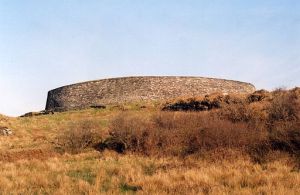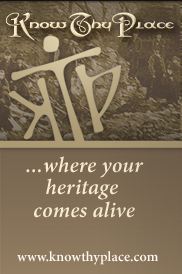Over the coming months this blog will explore the different types of archaeological monuments that can be found in Thy Place, and explain their archaeology and history. We start the series with the ubiquitous Irish Ringfort, a site found in almost every place on the Island.
The ringfort is one of the most common Irish field monuments, with estimates on their numbers varying between 30,000 and 40,000 throughout the country. Our current understanding of these structures is that they date to the Early Medieval Period, with a peak in construction between AD 600 and AD 900. They represent the enclosed homesteads (farmhouses if you like) of the upper echelons of Irish Early Medieval society. While the term ‘ringfort’ dominates, other terms are also used such as rath, lios, caiseal and dun – rath and lios are normally used to describe monuments with earthen banks while caiseal (cashel) and dun are more generally used in relation to sites with stone-built enclosures. These names are often fossilised in placenames throughout Ireland today, for example Rathmines in Co. Dublin (the Fort of Maonas) and Lisburn in Co. Antrim (the Fort of the gamblers). The decision on whether they were constructed of earth or stone was often influenced by the local landscape and the most readily available material.
In general ringforts, as the name suggests, consisted of a circular space enclosed by one or more banks and ditches. These generally have an internal diameter of between 15m and 35m (50ft to 115ft), but variations to this rule are known. Excavation within some of these structures has revealed that they had multiple functions. Some investigations of the interior have uncovered nothing, which led the excavators to interpret them as cattle enclosures. In general however it is believed that they housed an extended family, and the more usual arrangement consists of a large central building, usually circular in plan, with some associated out-buildings nearby. Excavations have also revealed other structures which may have been used for agricultural purposes such as cereal drying kilns, or light industrial activities such as smithing furnaces.
The early Irish law tracts set out the size and morphology of enclosures and homes for various classes of people in early Irish society. For instance the bóaire or ‘cow lord’ was entitled to a house of 8.23m, an out-house of 4.57m, a kiln, a barn, a sheep-fold, a calf-fold and pigsty.
The term ‘Ringfort’ is probably something of a misnomer, as these sites were almost certainly incapable of withstanding any form of determined attack. Although they may have provided refuge from wild animals and fast moving cattle-raiding parties, they were most likely constructed as a show of wealth by the individual in control of the area, a testament to powerful individuals which in many cases has stood the test of over 1,000 years of history.







“ONE OF THE MOST sustained monolithic traditions of Irish archaeology is the classification of a wide variety of earthen and stone enclosures (ráth and caisel) as ‘ring-forts’. This is an impediment to understanding the significant changes that native enclosed settlement underwent through time since it encourages archaeologists to fit their evidence to the category rather than to assess each enclosed settlement on its own merits. It also conceals differences between various forms of enclosed settlements inhabited from the 7th to the 17th century AD, occasionally later. The proposal is therefore that the ‘ring-fort’ is a chimera and that the use of that term should be discontinued so that study of native enclosed settlement can be liberated
from its insular base and used to explore social change in Ireland.” (Fitzpatrick 2009)
I like the blogg, but a little traditional at this stage (see above). Without over complicating matters too much it might be nice to add some detail of recent research: Tulsk, the Burren etc.
Kind Regards
Ros
Hi Ross
Thanks for your comments which I wholeheartedly agree with. However the blog is designed to be read in conjunction with the wall charts produced by Know thy place rather than higher level academic discussions. Having said that I think it is great that comments like yours are added to the blog which provide people with an avenue to explore these issuses at a deeper level. Our plan is to pursue the more traditional line with all the ‘know thy monuments’ blogs – we will be delighted if that stimulates further discussion. Fulachts fiadh are coming up next week which could lead to a bit of debate!
Colm
Oh full ref: Fitzpatrick, E. (2009) ‘Native Enclosed Settlement and the Problem of the Irish ‘Ring-fort”, Medieval Archaeology, 53, 271-307.
Pingback: The first President’s Place! The ancestral homeland of Barack Obama | Know Thy Place Blog
Pingback: Seminar XCIII: in the tracks of the Celtic Tiger « A Corner of Tenth-Century Europe
Pingback: The Big Dig at Caherduggan Castle: Cracking Castle and Mega Moat | Headlines